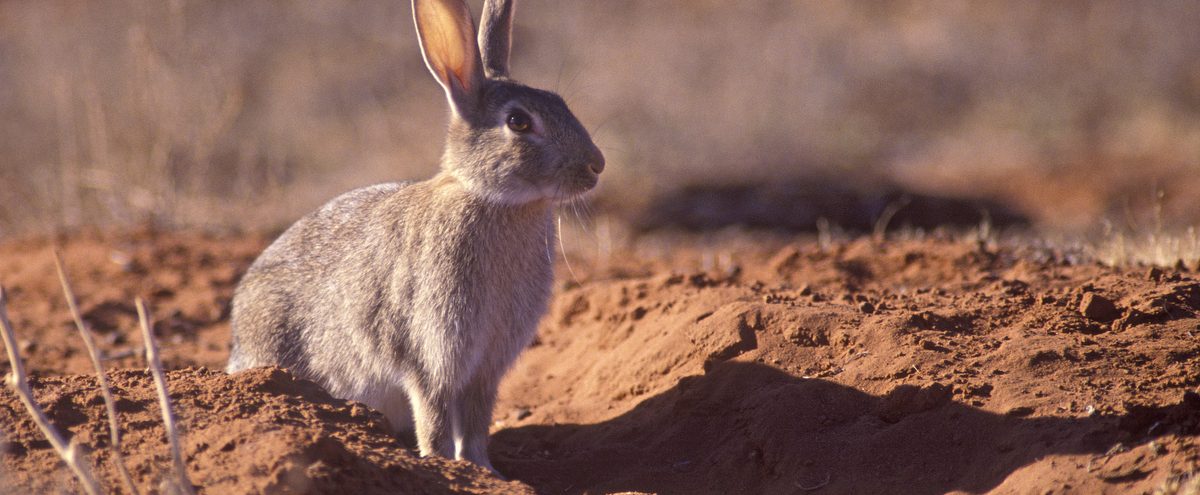
Rabbits

Rabbits are a serious invasive pest in Australia, causing millions of dollars in damage to crops and the natural environment. The dispersal of the rabbit in Australia was the fastest of any invasive mammal in the world.
Feral rabbits vary in colour but typically have grey-brown fur with a white-grey belly, long ears, long hind legs, short front legs and a short fluffy tail. Slightly protruding eyes on the sides of their head give them panoramic vision which helps them detect predators. Adult rabbits weigh up to 2.3 kg and can be up to 45 cm long.
Rabbits are herbivores and can graze plants to ground level, eating up to a third of their body weight daily. If their food sources have an adequate moisture content, they do not require access to water.
Wild rabbits form territorial groups, comprising 1-3 males and 7-10 females, led by a dominant pair. Females can breed all year round, starting from 3 months old. They can have 5 or more litters in a year, with up to 7 kittens each time. A single pair of rabbits can increase to 184 individuals within 18 months.

Rabbits depend on warrens or other shelter, are most active from dusk until dawn, and are highly susceptible to predators.
Where are rabbits found?
Rabbits are widely distributed across Australia and occur in a large variety of habitats. They prefer low vegetation that has refuge such as scrub, bushes or fallen logs. Rabbits build large warrens up to 3 m deep and 45 m long that provide cover and protection both from predators above ground, as well as extremes in temperature, helping them survive hot Australian summers. In areas of abundant surface cover, they may live predominantly above the ground.

What are the impacts of rabbits?
Rabbits graze on native vegetation, selectively feeding on certain species of plants at critical stages of their development such as at seeding and seedling establishment. They directly compete with native wildlife for food and shelter and their digging leads to a loss of vegetation cover which then results in slope instability and soil erosion. There are at least 304 Australian threatened flora and fauna species that have been adversely affected by competition and land degradation by rabbits. Even at one rabbit per hectare, rabbits are able to prevent the regeneration of some of our most vulnerable flora species.
Rabbits grazing emerging crops and pastures can result in yield losses of up to 100%. Rabbits increase competition for feed with livestock, potentially affecting the carrying capacity on a property. This can lead to lower weight gain, lower wool production, reduced births and a higher mortality rate during drought. As rabbits graze more closely to the ground than livestock, they can potentially eliminate perennial grasses from established pastures. Pastures are then likely to be invaded by broadleaf weeds and annual grasses, making them less suitable for livestock production. Rabbits cost Australian agriculture over $200 million in production losses each year.

Rabbits can damage lawns, gardens, golf courses, sports grounds and regional parkland reserves. They can undermine buildings, garages, and sheds, causing conflict in urban areas. Rabbits can also spread disease to humans and animals.
What are my responsibilities as a landholder?
Landholders are responsible for the control of rabbits on their properties under the Landscape South Australia Act 2019.
In the Murraylands and Riverland region, rabbits are prohibited from being:
Moved
Sold
Kept as a pet*
Released
*Domestic rabbits (pet store specialty breeds) are able to be kept as pets; however, they are prohibited from being released.
How can rabbits be controlled?
Rabbits can be controlled by baiting, warren ripping, warren fumigation, biological control, trapping, and warren blasting. It is important to have a rabbit management plan that relies on a combination of strategies and techniques to keep on top of the rabbit problem.
Baiting
There are two bait options available from the MRLB, depending on your situation and several criteria. Typically the most effective time for baiting programs is during the warmer, drier months. For more information on types of bait and best practice please see:
Warren ripping
This typically involves heavy machinery to collapse in warrens, removing a place for them to hide. For more information on best practice please see:
Warren fumigation
A control tool best used as follow up after baiting and ripping. For more information and best practice please see:
Biological control
This can be accessed from the Murraylands and Riverland Landscape Board, and effectiveness will depend on your location and time of year. For more information on biocontrol as a control tool, please see:
Trapping
Best used when other control tools have already been deployed. Steel-jaw leg-hold traps are no longer permitted for use in South Australia. For further information about this, and best practice, please see:
Warren blasting
A control tool most suitable in areas that are difficult to reach with other traditional methods, or as follow up. For more information on this and to assess suitability, please contact your local landscape board district officer.

How can the landscape board support landholders?
The Murraylands and Riverland Landscape Board can provide expert advice, bait layers, baits, biocontrol and fumigation devices to landholders in the region. Contact your local district officer to find out more.
